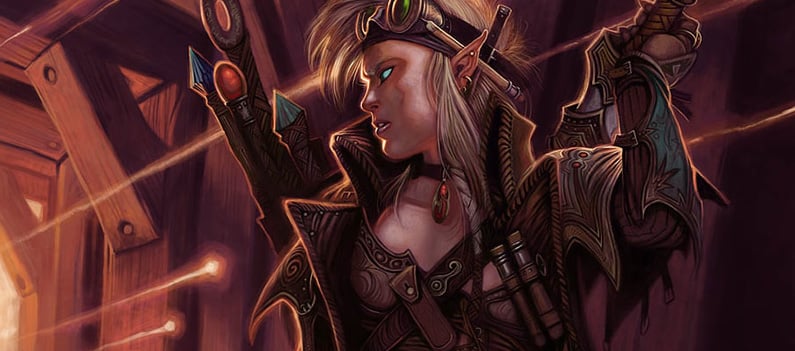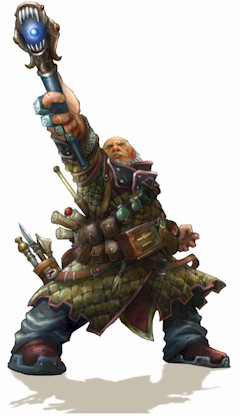D&D: Unearthed Arcana – Artificer


Trapped in a dungeon with only 30′ of rope, a broken lockpick, and half a warforged’s shin. Good thing the Artificer is back in the new Unearthed Arcana…
That’s right! There’s a brand new class up for playtest this week on Unearthed Arcana–I’m so excited about this I don’t even have a joke here. This is something I’ve been hoping to see for a while. I think there’s been a dearth of options for players, and getting to see a class (especially one that was introduced in Eberron BOTH TIMES) is pretty cool.
I am not going to hold my breath that this class in particular means that there will be a 5e Eberron announcement any time soon, even if it would be an absolutely perfect setting for 5th edition with its flexible yet crunchy rules–think about it, you could do Dragonmarks as alternate subrace packages, add a few new classes and player archetypes to situate them in Eberron and you’d be set.
But even if that’ll never happen, I am still eager to see new classes coming out. So without further adieu, let’s dive in and check out the Artificer!
Makers of magic-infused objects, artificers are defined by their inventive nature. Like wizards, they see magic as a complex system waiting to be decoded and controlled through a combination of thorough study and investigation. Artificers, though, focus on creating marvelous new magical objects. Spells are often too ephemeral and temporary for their tastes. Instead, they seek to craft durable, useful items.
Artificers are all about crafting and invention–whether it’s the weapons they use, magic items, or weird alchemical tricks, creation is at the core of any artificer. The Fifth Edition Artificer is no different. They get a number of class features that let them create magic items, mechanical companions, even infuse spells into items for later use (more on this in a moment)–of particular interest, they are the first class to get a cantrip (sort of) that scales beyond 4dX. All in all it’s a pretty cool concept. I’m a little unsure of the execution, but hey, that’s what playtesting is for.’
The Basics
To start with, Artificers are decently sturdy. With a d8 hit die and medium armor proficiency, they are about as tough as clerics–with the simple weapon proficiency to match. And owing to their nature as inventors and craftsmen, they are proficient with all kinds of tools. You get Thieves’ tools and two others of your choice, as well as Con and Int saves and a pretty varied list of skills to choose from.
Class Features
Artificer Specialist
This is the class archetype–and it does a lot of work. You get it at 1st level, and it colors every action you’ll be taking as an Artificer. Moreso than most, I think. There are only two archetypes to choose from here, the Alchemist and the Gunsmith, both of which are covered in more detail below.
Magic Item Analysis
A cool flavorful feature–you know and can cast Detect Magic and Identify as ritual spells (and don’t need the 100gp pearl for Identify).
Tool Expertise
Doubling your proficiency bonus with tools is always nice. Very much in keeping with the artificer’s theme of being a crafter, and is even better when you consider that musical instruments and gaming sets (like Three Dragon Ante) are considered tools in 5e. So you could in theory have a lazy artificer who doesn’t actually know what they’re doing (but is good at games and can play the lute). This pleases me.
Wondrous Invention
This one is interesting. So, as you level up, your artificer is considered to be constantly working or creating. And this feature gives you a magic item (off a limited list) for free at 2nd, 5th, 10th, 15th, and 20th level. I’m not sure how well this one works out–it seems good for situations like league play, where you can’t really go out of your way to try and get a magic item–but on its own, I’m not sure. This is a feature that you can also just replicate with the right adventures/gold in your own campaign. Still, I think it’s a good way to get a bunch of items that you might not otherwise have found.
Spellcasting
Starting at 3rd level, you gain access to a limited selection of spells. You cast them much like a bard or sorcerer–albeit at a slower rate. You’ll only get up to 4th level spells (and those not until 19th or 20th level), but the list is a very solid support caster list. You’ll never be blasting your enemies with magic (at least not with spells), but you’ll always be able to have a trick or two up your sleeve for when the going gets tough and your party needs that extra oomph.
Infuse Magic
This is the Artificer’s big specialty. The ability to infuse an item with magic–at 4th level, you gain the ability to store a spell in an item. You’ll never do it on the fly (infusing an item requires you to extend the spell’s casting time to 1 minute), but you can then hand the item to someone else who can use an action to use it.
This one is the ability I’m the least sure about. I mean, it sounds cool–and I definitely like the idea of being able to hand a spell to someone else, but I’m not sure of the cost. Storing a spell expends one of your slots (which are at a premium already), and it still requires an action to use. Granted, you can give it to someone else who can use it on their turn (freeing you up to do something else), but it takes their action. So in order to use this feature you’re giving up a lot of flexibility. One of the biggest things about spells in Fifth Edition is that they’re not locked into place–even Wizards prepare a list of spells that they then select from for their spell slots. But if you Infuse a spell, you’re giving up the potential to use that slot to cast a different spell if the situation you’re storing it for doesn’t come up.
And sure, you can just use it for spells that you know you’re always going to cast, like giving haste or magic weapon to your fighter–but it almost feels like, if you were going to do that anyway, you’d be just as fine just casting the spell normally. To be fair, you can pass off self-only spells this way–but Artificers don’t actually have that many on their list. Disguise Self, Expeditious Retreat, False Life, Alter Self, Blur, See Invisibility, and Blink are the only ones I could find. It just seems like an awful lot of work for something you could just do.
And while it is cool, I’m not sure it’s worth a class feature, if that makes sense. I could definitely be wrong on this one, though. Maybe there’s some hidden trick to this I’m just not seeing.
Superior Attunement
You can attune to an extra magic item at 5th, and then again at 15th level. This one is pretty powerful–many of the best magic items require attunement, and you can use more of them. Very much on theme here.
Mechanical Servant
Probably my favorite ability. You create your own construct that duplicates a large beast of CR 2 or less. It can look however you like, and, more importantly, it acts on its own, obeying your orders to the best of its ability. So, it’s like an animal companion you don’t have to give up part of your action to command. Admittedly it doesn’t ever gain the multiattack that a Beastmaster ranger’s pet will gain–but it’s still fairly useful. And cool–after all, who wouldn’t want their own robo-giant spider, dire wolf, brown bear, or axe beak?
I don’t think that’s what they meant…
Soul of Artifice
The 20th level capstone ability is strong. You can attune to 6 items at once (instead of the three that non-artificers are stuck with) AND you get a +1 bonus to all saving throws per item you’re attuned to. So, I hope you like making your saves, because you will be.
Artificer Archetypes
Alright, now let’s run through the two artificer archetypes they’ve offered up: the alchemist and the gunsmith.
The Alchemist is all about combining reagents and such on the fly, creating a variety of effects as needed. If you’ve got a problem to solve, the alchemist will offer you a number of ways to try and deal with it.
Alchemist’s Satchel
You create a magic bag that somehow always has the right kind of reagents and components you need to create a neverending supply of tricks. I really like this idea–you’re considered to be constantly harvesting reagents and constantly fumbling with them. It’s a utility belt, basically. And you can choose three Alchemical Formulas which you know how to create on the fly. You know three at 1st level, then eventually pick up the rest as you level up as an alchemist.
Alchemist’s Fire: Burn friends and influence people! You can toss a vial of fire at your enemies, an object, or even just a square on the ground–either way, pick a target within 30 ft. The vial detonates in a 5-foot radius burst around that point, dealing damage dependent on level. Interestingly enough, this damage scales beyond the normal 4dX scaling of cantrips–and this ability reminds me a lot of a cantrip–there’s no limit to the number of times you can do this. Only this ability scales up in damage to 19th level. You’ll do more damage, and faster, with this one. The only downside (and it’s a pretty big downside) is that enemies can save–and if they do save, they take nothing.
Alchemical Acid: Like Alchemist’s FIre, but it’s acid and only effects one creature. Oh, and it scales up much faster, increasing by 1d6 every odd-numbered level. Both this and Alchemist’s Fire are strong–you don’t have to roll to hit. And sure, your enemies get to make one of the more common saves (so there’ll be many a round where you use this to no effect), but even that is outweighed by how useful it is.
Healing Draught: Speaking of usefulness–this ability lets you combine a healing draught from reagents in your satchel. You can then pass it to any creature (who uses an action to drink it, gaining 1d8 hit points (or more, depending on level) when they do. You can only have one of these created at a time, and a creature can only benefit from this healing once per extended rest–but even then, it’s still an incredibly powerful heal. This is easily one of the best abilities the Alchemist gets.
Smoke Stick: Obscuring mist on a stick–you create a 10-foot cloud of darkness that blocks even darkvision and lasts for about a minute. You can only use it once a fight, (okay, once per minute, but realistically, that’s about as often as you’ll need it), but it’s useful for covering a hasty retreat, or protecting yourself from ranged attacks, or the like.
Swift Step Draught: You create a speed potion–anyone drinking this gains +20 to their movement speed for a minute. Once you’ve used one of these draughts, you can’t benefit from one again for another minute. Another really strong support ability. Pick this one up and your party will almost always be able to get where they need to go. Especially if you pick up Haste or the like.
Tanglefoot Bag: This one is a little different from the tanglefoot bag we all know and love. This version creates a 5-foot radius burst (so 4 adjacent squares) of difficult terrain. And you can only do this once per minute. This one feels a little more situational than the previous examples.
Thunderstone: Hurl a stone and send your enemies flying. Can’t go wrong here. Pick a 10-foot radius explosion and anyone that fails a Con save is pushed back 10 feet and knocked prone.
So that’s the Alchemist. All in all, a pretty cool specialization. I think some of the abilities might need another little bit of tweaking–the fire and acid ones are really good–I don’t know about the Tanglefoot bag. But if you want to play the character who always has a backup plan, or an answer for everything, this is the archetype for you.
Gunsmith
Although, arguably, the gunsmith also has an answer for everything. It’s just that the gunsmith’s answer is invariably “shoot it with my gun that I built.” And that’s not a bad way to live your life if that’s what you wanna do. I won’t judge.
Q might, though.
Gunsmiths are all about their guns. At 1st level, you craft your own gun, called a THUNDER CANNON which is impossible to say in a normal voice. The THUNDER CANNON is pretty potent too. A two-handed ranged weapon that does 2d6, the THUNDER CANNON is a gun that basically shoots greatswords out to 500 feet (normal range 150 feet though, if you don’t want disadvantage).
It takes a bonus action to reload your THUNDER CANNON, and there’s a limited number of times you can use it–in theory. Each extended rest gives you a grand total of 40 greatsword bullets, and you can create 10 more during a short rest. If you need more than that, you’re either doing something incredibly wrong, or incredibly right.
THUNDER MONGER
Another incredibly metal ability–at 3rd level, you can make a special attack with your THUNDER CANNON, and add another short sword or two to your damage dice, scaling in level so that by 19th level you’re doing 11d6 with each shot (that’s 5 and a half greatswords, for those playing along at home). This ability is very strong–it’s the one I imagine you’ll be using the most. But it also represents the problem of the archetype–it’s all different ways of using your gun. And I’m not sure that the others are necessarily better than this one.
Blast Wave
At 9th level, you can fire your weapon in a 15-foot cone. Creatures must make a Strength save or take 2d6 damage ad be pushed back ten feet. At 13th and 17th level, you do more damage, but, especially since this is an ability you get at 9th level (when most cantrips are already doing 2dX) all you’re really doing is getting a cantrip. Admittedly a cool one, but a cantrip just the same. I think it’s nice to have the option, and I can definitely see this coming in handy–but I don’t think it’s nearly as core as some of the other ones.
Piercing Round
At 14th level, you gain another special attack for your THUNDER CANNON. You attack enemies within a 5-foot wide, 30-foot long line dealing either 4d6 or 6d6 (at 19th) to them on a failed Dex save. Again, this one is kind of neat in that it lets you attack multiple foes–but it just feels a little lackluster.
Explosive Round
At 17th level, you can shoot explosive rounds that hit a fairly large area. These are 30-ft radius spheres–the tradeoff is they only do 4d8 points of damage.
All in all, I think the class has some cool concepts, but I don’t think it’s quite there. I wonder why they doled out the abilities over time like that–I think it might be cool to pick a few special ammo types at the outset, and then gain more (kind of like with the Alchemist) but maybe that would make the archetypes too similar. I’m not real sure what this one needs, but it feels like it’s not quite at its final form yet.
And that’s the Artificer. Phew. This one was a little more in-depth, but it’s the first new class out so I really wanted to showcase what they’ve introduced with it. I’m excited to see whatever product these will be finally coming out in–and I really want to know how these will change from now until they’re done.
Again, these are just my initial thoughts, I haven’t had a chance to test out the Artificer yet (but you better believe I will be) so who knows, I could come back next week and say I was wrong about everything, THUNDER CANNON is life. We’ll see. As always, you should check out the whole article over at Wizards, and don’t forget to fill out that Paladin survey if you haven’t already.
Check out the Artificer
Take the Paladin Survey
What do you think of the Artificer? Would you change anything? If so, what? Let us know in the comments!







